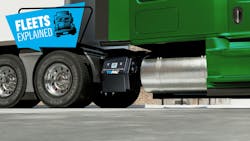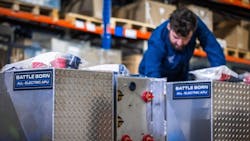A truck idles when its engine runs without moving the vehicle. Trucks idle regularly throughout the course of a haul, and more than one million long-haul heavy-duty trucks idle during rest periods every day.
Idling is often a necessary practice for driver comfort, yet idling reduction is an important quest for fleet management. Read below for information on why drivers idle, why fleet management tries to limit idling, and the dominant idling reduction devices.
See also: Fleets Explained: Emissions regulations
This is part of FleetOwner's Fleets Explained, a Trucking 101 series to break down aspects of the trucking and fleet management industries. You can read more from the series, launched in May 2024, at fleetowner.com/fleets-explained. To submit topic ideas, clarifications, and corrections, email [email protected].
Why do drivers idle?
Idling occurs whenever a truck runs its engine without moving—sitting at a red light, encountering a stop sign, backing into a spot, negotiating dense traffic, and so on. However, the most significant source of idling is to provide comfort: heating, cooling, and electricity, also known as “hotel load.”
Some powertrains and fuel mixes also experience problems with extreme cold. Though uncommon, temperatures below 0 degrees Fahrenheit can stop a cold engine from starting altogether, motivating some drivers to idle overnight out of concern.
Idle speeds
Some trucks allow users to adjust the engine rpm at idle. A low idle speed can reduce fuel use and overall engine cycles but could also unintentionally increase engine wear. Engine manufacturers generally provide a recommended idle speed for longevity, often somewhere between 700 and 1,000 rpm.
The costs of idling
Idling touches on some of the most expensive aspects of fleet operations: the driver, the tractor, and fuel.
Unnecessary idling means unnecessary engine wear and wasted fuel. Argonne National Laboratory estimates that a heavy-duty truck at idle consumes about 0.8 gallons of fuel per hour. With diesel at $3.78 per gallon, a truck idling about 1,800 hours per year can cost $6,804 annually in fuel alone. However, a fleet that goes too far micro-managing drivers’ idling could suffer higher driver turnover.
Many communities also have regulations to limit idling. At idle, engines continue to emit particulate matter and toxic pollutants. Fleets found to idle excessively can suffer fines, though the rules vary widely across the nation. The American Transportation Research Institute maintains a regularly updated compendium of idling regulations across states, counties, and cities.
According to the ATRI compendium, regulators generally tend to:
- Limit idling to three to five minutes or less
- Penalize excessive idling with fines of around $50 to $150
- Make exceptions for inspections, maintenance, traffic, and hours-of-service compliance
How to reduce idling
Fleets can find a wide range of idling reduction solutions catered to heavy-duty trucks. Each type of solution has its own advantages, and the best option will fit both the fleet’s unique duty cycle and the driver’s own preferences.
The Environmental Protection Agency maintains a verification program for idle reduction technologies, focused specifically on Class 8 long-haul trucks, called SmartWay. Argonne National Laboratory in 2020 also built a compendium of idling reduction technologies for Class 1-8 vehicles.
Some popular idle reduction techniques include:
Automatic engine controls
Idle management systems, also known as automatic engine start/stop (AESS), are relatively inexpensive solutions to automatically turn the engine on and off to maintain comfortable temperatures and sufficient battery charge. However, varying engine activity can disturb drivers’ rest.
See also: Clarios launches IdleLess: A battery service to cut idling by 60%
Auxiliary power units
An auxiliary power unit is a device that provides energy without starting the main engine. Often, APUs in trucking are smaller diesel engines, though some APUs can be electronic or use alternative fuels. APUs tend to be heavy and bear a high upfront cost. Some APUs that use separate battery systems and air conditioning systems are known as battery air conditioning (BAC) systems. A very simple type of auxiliary power device is the fuel-operated heater (FOH), which burns fuel for heat.
See also: Redefining the electric APU
Electrified parking spaces
Electricity is available at some truck stops to provide trucks with idle-free power. These are known as electrified parking spaces (EPS) or truck stop electrification (TSE). These powered spaces are ideal for regular, predictable hauls where a truck has reliable access to an EPS.
Training
Sometimes, an idling problem can be mitigated by educating the driver on the consequences and best practices of idling.
About the Author
Jeremy Wolfe
Editor
Editor Jeremy Wolfe joined the FleetOwner team in February 2024. He graduated from the University of Wisconsin-Stevens Point with majors in English and Philosophy. He previously served as Editor for Endeavor Business Media's Water Group publications.


